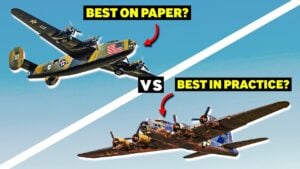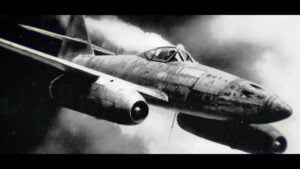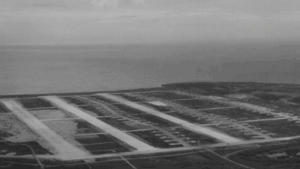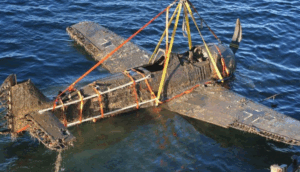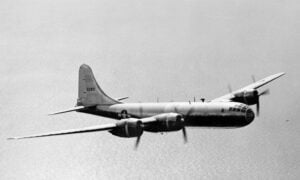7 Incredible WW2 Aircraft Modifications You Didn’t Know About

InfernoPlus / YouTube
World War II was a time of rapid change and innovation, especially in technology and weapons. Between 1939 and 1945, many new ideas emerged, particularly in aircraft design. Some of these ideas seem strange to us now, but they were a big deal back then. Here are some of the most interesting modifications made to aircraft during World War II.
1. The Mistel Combination Bomber and Fighter

One of the strangest aircraft modifications during the war was the German “Mistel” combination. This involved a bomber, usually a Junkers Ju 88, and a fighter, often a Messerschmitt BF109, being paired together. The bomber had its cockpit and nose section replaced with a large explosive device. The fighter would be attached to the bomber using special connectors. The combination would fly towards a target, where the fighter pilot would release the bomber to fall onto the target and explode. The bomber was unmanned and packed with explosives, making it a flying bomb.
The Mistel combinations were used towards the end of the war. Their first operational flight was in July 1943, and they were used in various operations, including the Normandy landings in 1944 and actions against the Soviet Union. However, their success was limited.
2. The Me 262 with a Mega-Cannon

Another interesting aircraft modification was the German Me 262A-1a/U4. This was a version of the world’s first operational jet fighter, the Me 262, equipped with a giant 50 mm cannon. The cannon, called the Mark 214A, was developed by Mauser and was similar to the 50 mm Pak 38 anti-tank gun.
Initially, the cannon was too complicated to be practical. However, a refined version was later developed and tested in 1945. The Me 262 with this mega-cannon never saw combat, much to the relief of Allied aircrews.
3. The Henschel Hs 129 with a 75mm Cannon

The Henschel Hs 129 was a ground-attack aircraft known for its ability to destroy tanks. To make it even more powerful, the Germans decided to equip it with a 75 mm anti-tank cannon. This version of the aircraft was known as the Hs 129 B-3.
Introduced in 1942, the Hs 129 mainly saw action in Tunisia and against the Soviet Union. Its most famous version had a fully automatic 75 mm Bordkanone (BK) 7.5 anti-tank cannon. This cannon featured a hydraulic recoil-dampening system and an autoloader that could hold 12 rounds in a rotary magazine. Despite its powerful armament, the aircraft had mixed success during the war.
4. The Schräge Musik Night Fighters

The Germans also developed a modification known as “Schräge Musik.” This involved fitting night fighters, like the Messerschmitt Bf 110 and Junkers Ju 88, with upward-firing cannons. The idea was for the night fighter to fly below enemy bombers and fire upward, making it harder for the bombers to detect the attack.
This modification proved very effective. The bombers had a difficult time spotting the night fighters coming from below, giving the German pilots a significant advantage. The aircraft used in this role also had special ammunition with glowing trails, armor-piercing, explosive, and incendiary rounds. This modification was not entirely new; similar ideas had been used during World War I to shoot down airships.
5. The Twin P-51 Mustang, XP-82

One of the strangest aircraft modifications by the Americans was the twin-P51 Mustang, known as the XP-82. This aircraft essentially joined two P-51 Mustangs together with a shared wing and rear horizontal stabilizer. It was designed to be a long-range escort fighter for bombers like the B-29 Superfortress.
The XP-82 first flew in June 1945, but it went into production after the war had ended. Later called the P-82, it served as a long-range escort fighter for the Strategic Air Command. Equipped with radar, it replaced older aircraft in the Air Defense Command and saw service in the Korean War before being retired in 1953.
6. The Vickers Wellington Mk DWI

The British also had some unusual aircraft modifications. One such example is the Vickers Wellington Mk DWI, designed for magnetic mine detection and clearance. “DWI” stood for “Detonation Without Impact.”
This aircraft had a Ford V-8 engine and a generator to create a magnetic field in a large loop around the fuselage. The loop, supported by a nose bracket and rear fuselage and wing brackets, generated a magnetic field during flight. This field would set off magnetic mines as the aircraft flew over them. The Vickers Wellington Mk DWI was very successful in clearing mines and was one of the oddest-looking aircraft of the war.
7. The “Messerspit” Hybrid

Lastly, there was the “Messerspit,” a unique hybrid aircraft. This was a British Royal Air Force Spitfire Mark Vb fitted with a German Messerschmitt Daimler-Benz engine. The original Spitfire was captured after landing in German-occupied Jersey and sent to Germany for testing.
German engineers replaced its Rolls-Royce Merlin 45 engine with a Daimler-Benz DB 605A engine and fitted it with a propeller and carburetor scoop from a Messerschmitt Bf 109G. The modified aircraft had better visibility and ground handling compared to the Bf 109. After extensive testing, it was finally destroyed in a bombing raid in August 1944, marking the end of its special role.














